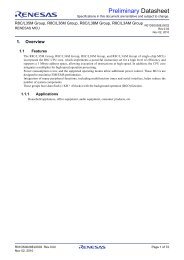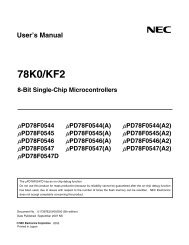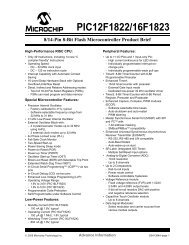xmega a3u - Elfa
xmega a3u - Elfa
xmega a3u - Elfa
Create successful ePaper yourself
Turn your PDF publications into a flip-book with our unique Google optimized e-Paper software.
XMEGA A3U<br />
7.5 Data Memory<br />
The data memory contains the I/O memory, internal SRAM, optionally memory mapped<br />
EEPROM, and external memory if available. The data memory is organized as one continuous<br />
memory section, see Figure 7-2. To simplify development, I/O Memory, EEPROM and SRAM<br />
will always have the same start addresses for all Atmel AVR XMEGA devices.<br />
Figure 7-2.<br />
Data memory map (hexadecimal address).<br />
Byte Address AT<strong>xmega</strong>192A3U Byte Address AT<strong>xmega</strong>128A3U Byte Address AT<strong>xmega</strong>64A3U<br />
0 I/O Registers<br />
0 I/O Registers<br />
0 I/O Registers<br />
FFF (4K)<br />
FFF (4K)<br />
FFF (4K)<br />
1000 EEPROM<br />
1000 EEPROM<br />
1000 EEPROM<br />
17FF (2K)<br />
17FF (2K)<br />
17FF (2K)<br />
RESERVED RESERVED RESERVED<br />
2000 Internal SRAM<br />
2000 Internal SRAM<br />
2000 Internal SRAM<br />
5FFF (16K)<br />
3FFF (8K)<br />
2FFF (4K)<br />
Byte Address<br />
AT<strong>xmega</strong>256A3U<br />
0 I/O Registers<br />
FFF<br />
1000<br />
1FFF<br />
(4K)<br />
EEPROM<br />
(4K)<br />
2000 Internal SRAM<br />
5FFF<br />
(16K)<br />
7.6 EEPROM<br />
7.7 I/O Memory<br />
XMEGA AU devices have EEPROM for nonvolatile data storage. It is either addressable in a<br />
separate data space (default) or memory mapped and accessed in normal data space. The<br />
EEPROM supports both byte and page access. Memory mapped EEPROM allows highly efficient<br />
EEPROM reading and EEPROM buffer loading. When doing this, EEPROM is accessible<br />
using load and store instructions. Memory mapped EEPROM will always start at hexadecimal<br />
address 0x1000.<br />
The status and configuration registers for peripherals and modules, including the CPU, are<br />
addressable through I/O memory locations. All I/O locations can be accessed by the load<br />
(LD/LDS/LDD) and store (ST/STS/STD) instructions, which are used to transfer data between<br />
the 32 registers in the register file and the I/O memory. The IN and OUT instructions can<br />
address I/O memory locations in the range of 0x00 to 0x3F directly. In the address range 0x00 -<br />
0x1F, single-cycle instructions for manipulation and checking of individual bits are available.<br />
14<br />
8386B–AVR–12/11
















